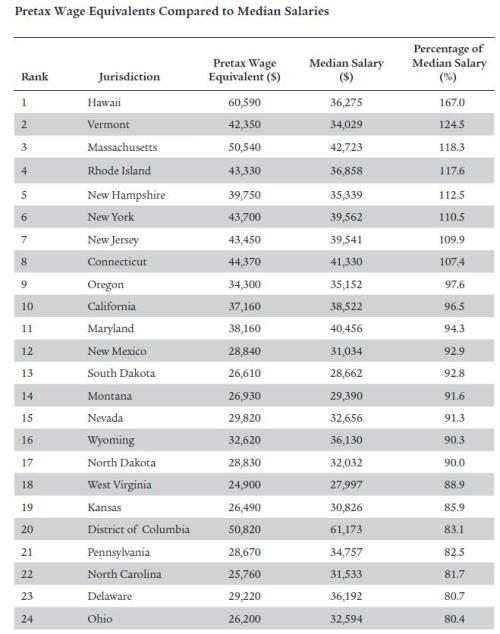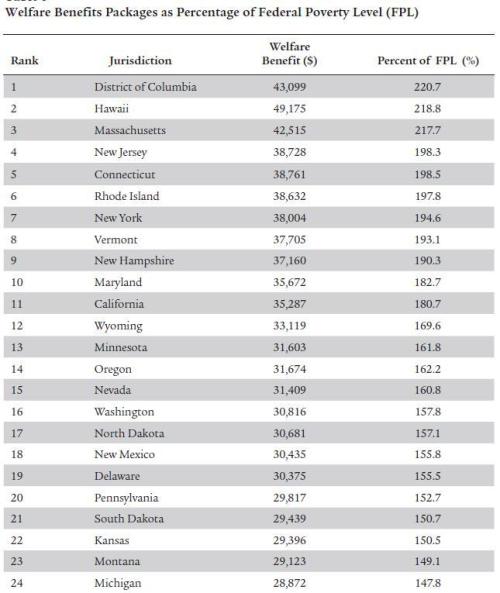About two years ago, I shared a map put together by a pro-statism organization that supposedly showed that welfare benefits were very miserly and not sufficiently generous to lift people out of poverty.
 My gut instinct was to reject the findings. As I wrote at the time:
My gut instinct was to reject the findings. As I wrote at the time:
The poverty line is set considerably above a level that would indicate material deprivation…far above the average level of income in most nations of the world. …Welfare checks are just one of many forms of redistribution, and the data used to create the map do not count food stamps, Medicaid, housing subsidies and a plethora of other means-tested programs.
My skepticism was further augmented when I ran across an amazing chartshowing that it made more sense to live off the government in Pennsylvania rather than earn more income.
It turns out that I was right to be skeptical. My colleagues at the Cato Institute have just released a detailed study calculating the amount of handouts available in each state. They then investigated whether the level of redistribution was so high that people might decide it didn’t make sense to be productive members of society.
Recommended
You probably won’t be surprised to learn that it’s better to live off the government in most states.
Welfare benefits continue to outpace the income that most recipients can expect to earn from an entry-level job, and the balance between welfare and work may actually have grown worse in recent years. The current welfare system provides such a high level of benefits that it acts as a disincentive for work. Welfare currently pays more than a minimum-wage job in 35 states, even after accounting for the Earned Income Tax Credit, and in 13 states it pays more than $15 per hour.
Here are some of the details from the study, which used the example of a mother and two children.
…the federal government currently funds 126 separate programs targeted toward low-income people, 72 of which provide either cash or in-kind benefits to individuals. …no individual or family receives benefits from all 72 programs, but many recipients do receive aid from a number of the programs at any given time. …this study seeks to determine the approximate level of benefits that a typical welfare family, consisting of a single mother with two children, might receive, and to compare those benefits with the wages that a recipient would need to earn in order to take home an equivalent income.
What shocked me the most were a couple of tables showing how living off the taxpayers is a pretty good deal.
The first table shows how much a household would have to earn – before tax – to have the same lifestyle that is available from the welfare system. The study also looks at median salary in each state and shows that eight states actually provide handouts that are greater than that amount!
The study also reveals that handouts give recipients far more than is needed to reach the federal poverty level. Indeed, the panoply of benefits is so excessive in some places that recipients are pushed to more than twice what is needed to get out of poverty.
Or maybe it would be more accurate to state that handouts are so excessive that recipients are lured into dependency.
I’ll close with a couple of surprises from the study. I was shocked that Illinois and Maine both ranked among the least extravagant states. Maine “earned” third place in the Moocher Index, so I assumed they would be especially profligate. But I guess having a lot of people on welfare doesn’t necessarily mean that they’re getting a lot of money.
And Illinois has veered far to the left on fiscal policy in recent years, so I assumed politicians were giving out lots of goodies. But apparently bureaucrats are first in line for handouts and that reduces the amount of loot available for other groups.
On the other hand, I didn’t expect to find New Hampshire being about as profligate as Vermont.
Most of the other states are where you would expect them to be. Fiscal hell-holes like New York and California redistribute money like crazy, while zero-income tax states such as Texas, Florida, and Tennessee are comparatively frugal.
P.S. Here’s a map showing which states have the most food stamp dependency.
 P.P.S. Let’s not forget that the poverty rate was falling steadily before the federal government declared a “War on Poverty.”
P.P.S. Let’s not forget that the poverty rate was falling steadily before the federal government declared a “War on Poverty.”
P.P.P.S. If you’re thinking about moving, you may want to avoid “death spiral states.”
P.P.P.P.S. The U.K. welfare system also makes work unattractive compared to living off taxpayers.




